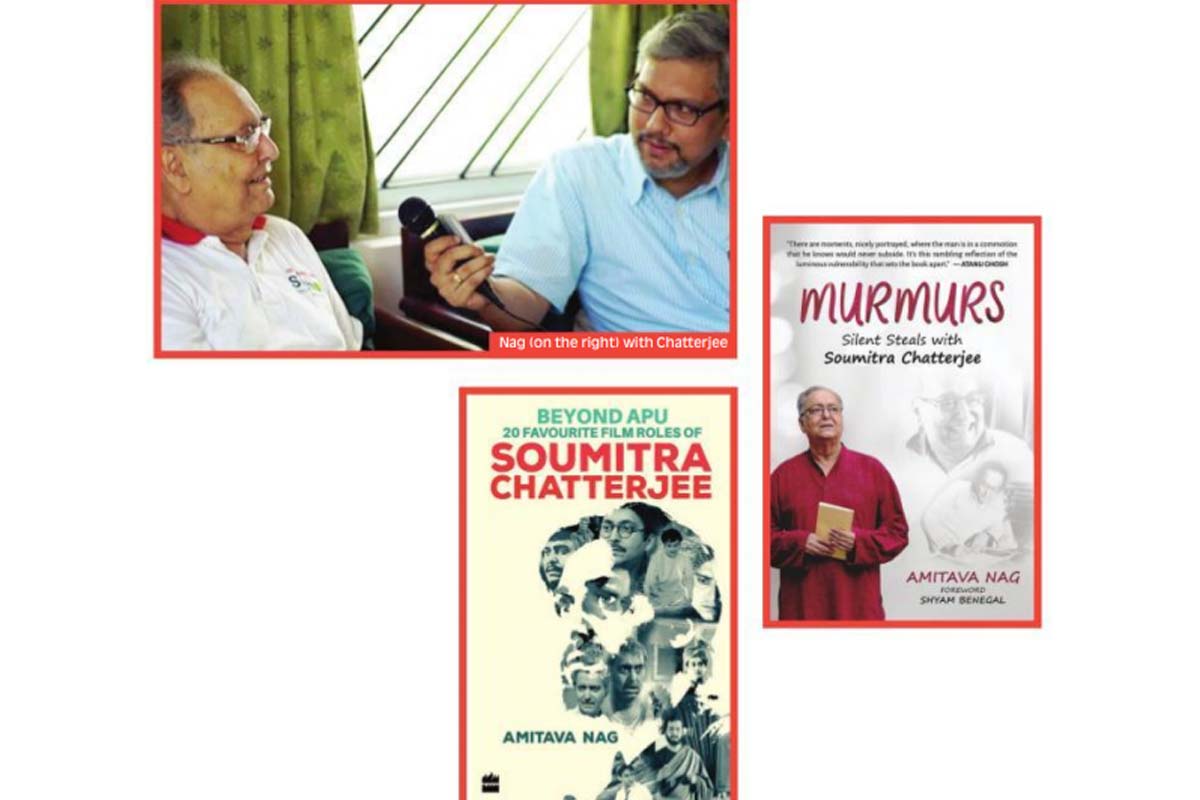According to the dictionary, murmur means “a low, continuous background noise”. Bluepencilpublishers.com has brought out a unique book by Amitava Nag, called Murmurs: Silent Steals with Soumitra Chatterjee, consisting of the author’s informal conversations with the great film personality.
Nag has already authored the much discussed Beyond Apu:20 Favourite Film Roles of Soumitra Chatterjee, followed by Satyajit Rays Heroes and Heroines. He has been a film critic involved with European and international cinema from the time he was a student of science at Presidency College, Calcutta.
The passion for cinema never deserted him and Nag continues to engage in the form through an outstanding digital magazine he edits called Silhouette.
He has written several books on poetry and other books on cinema, both in English and Bengali as he has equal command over both languages.
Murmurs has a brief but succinct foreword by Shyam Benegal, who was a great admirer of Soumitra Chatterjee through his admiration for Satyajit Ray
The distinguished filmmaker writes about the book, “This is a marvellous portrait of the great actor. You get to hear him, know him, in an extraordinarily intimate fashion. Once you have finished reading these musings of Soumitra Chatterjee, it is as though you were listening to a close friend, almost a confidante.”
The book is divided into 20 brief chapters, which almost completely comprise ambivalent musings by the author about interactions with his subject – Soumitra Chatterjee.
That spells out a seemingly insurmountable journey in itself – two men, distinctly different in age, experience and fame, have conversations, where the older man is the focus with the younger one looking in. Murmurs is in a genre of its own. It is entirely unstructured or rather, develops a unique structure unto itself as it goes along.
Though Chatterjee is the subject, who is in continuous dialogue with Nag, one feels it is also a dialogue that the author has with himself. At places, it feels like a monologue entirely from the perspective of the author as the subject gets subsumed by Nag and vice versa. During the interactions spread across a year or two, with intermittent pauses between visits, Nag, as is evident from his writing, managed to wholeheartedly involve Chatterjee in the discussions.
He also persuaded the screen icon to permit the translation of a book of poems by him. Published originally in Bengali by Chatterjee, the English translation was published as Walking Through the Mist in 2020.
In the opening chapter “Trees”, the author compares Chatterjee to a huge tree, probably inspired by a documentary called Gaach, the Bengali word for tree, directed by Catherine Berge. One paragraph describes this in detail as follows, “Trees, to me, define gravity, balance, space, murmur, peace and arrest time. Trees make us believe that life has been the same and also that it has flown down our winter sleep. Trees remind us of timelessness. Eternity.”
The lines fit into the massive expanse of Chatterjee’s genius while also reflecting, at an ideological level, a dream the letter-writing author aspires to achieve. He ends the chapter with just a single sentence, “Soumitra Chatterjee reminds me of the same – the unrepeatable moments of standing still.” I do not imagine anyone else has been able to describe the massive tree of talent and accomplishment called Soumitra Chatterjee quite in the same way. In the chapter “Letters and Interviews”, the author describes how he looks at the practice of letter writing, which is almost a lost art today.
Then, extremely slowly, he approaches the moment when he decided to write a letter to Chatterjee. He reminisces about that red, cylindrical box that held up hopes for many young people, destroyed the hopes of some older ones and how, neither of the two letters he wrote to Chatterjee elicited any response. It is more about the author than his subject. In “Care”, the author describes in elaboration, a young woman who was Chatterjee’s caregiver over a certain period of time.
Writing how marriage changed her into a confident, slightly plump and talkative woman, Nag goes into detail thus, “the increased weight laid bare the different colours of skin on her arms due to some infection. I don’t think she was bothered. She smiled at me, asked me how I was for these years in between.”
This chapter, therefore, is more about the author’s reminiscences about his own experiences in which his subject has no role to play, except in the form of the woman who was his caregiver. One great merit of the book, in its entirety, lies in the fact that Nag doesn’t try to intrude into the private world of Chatterjee or pester him with probing questions on his personal life.
Not even once. And yet, the book unravels layers of both the author and his subject with subtlety, restraint and respect, which could have easily descended into a gossip magazine article in less able hands. The only reservation I have about Murmurs can be expressed more by a question than comment.
The author always refers to his subject by the personal pronouns he, his or him but never by his proper name. One would love to know why.












